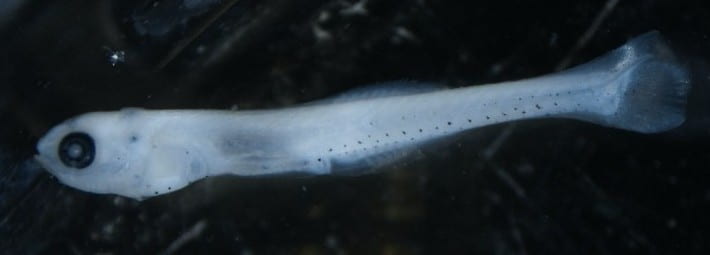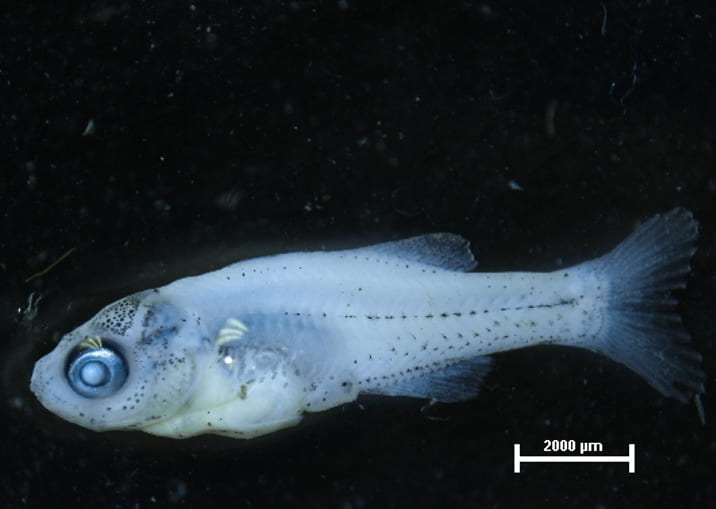Key Characteristics:
- Roughly equal number pre and post-anal myomeres.
- Fewer total myomeres than Percidae (less than 35).
- Double dorsal fin, but this may not be visible until they are older.
- Dorsal and anal fins across from each other.
- As they age, become deep bodied
- Can have many or few melanophores.

Larval Bluegill. 5.5 mm. United States Fish Wildlife Service. Burns Harbor, IN. Adam Dziewa. 2018.

Larval Bluegill. United States Fish Wildlife Service. Burns Harbor, IN. Marian Shaffer. 2017.

Examination of Larval Bluegill’s Head. United States Fish Wildlife Service. Burns Harbor, IN. Marian Shaffer. 2017.

Larval Bluegill. 8.1 mm. United States Fish Wildlife Service. Burns Harbor, IN. Adam Dziewa. 2017.

Larval Bluegill. 11.4 mm. United States Fish Wildlife Service. Burns Harbor, IN. Ashley Smith. 2017.
- Body not elongated, eel-shaped, round in transverse section, uniformly pigmented (1B)
- Chin barbels absent (3B)
- Snout short, its length usually less than 10% TL; median fins otherwise (5B)
- Median fins or finfolds showing distinct separation (7B)
- No adipose fin, or demarcation of one, in finfold (10B)
- Preanal myomeres greater than or equal to postanal myomeres (14A)
- Preanal myomeres approximately equal to postanal myomeres (difference five myomeres or less) (15A)
- Total myomeres less than 35 (20B)
- Total myomeres between 26 and 34 (21B)
- Adipose fin or its position absent (23B)
- Double Dorsal Fin (24A)
- (Centrarchidae)
Adult History
- Physical Description
- Small-mouth, round and flat body, dark spots on gill and dorsal fin, dorsal fin with two lobes, no adipose fin, 39-45 ctenoid lateral scales, 5-9 dark vertical bars on sides, yellow underside, and the tail is slightly forked yet rounded
- Spawning Habitat
- Shallow areas of lakes and ponds with aquatic vegetation
- Between 6 inches and 4 feet deep
- Spawning Substrate
- Eggs are deposited on sand or fine gravel
- Spawning Behavior
- Males build the nest
- Circular shallow depressions in water less than a meter deep
- Spawn in colonies
- Males change colors during the breeding season
- Male grunts to attract females
- Once the female approaches the male, they both swim in circles and touch bellies
- Females can deposit their eggs in multiple male nests
- Males guard the nest (before and after egg deposition)
- Parental Care
- Fanning eggs & chasing away predators
- Time of Year
- May-August in Lake Michigan
- Spawning typically takes place at water temperatures of 60 – 90°F
- Diet
- Omnivore
- Leeches, small fish, insects, snails, algae, zooplankton, and crustaceans
- Males build the nest

